From the February 2016 issue of GCM magazine:
Disease updates
Editor’s note: Each year, reports of previously unknown diseases, sightings of diseases in areas where they had not been seen before, and other news of diseases related to turfgrass are published in the scientific literature. From time to time, GCM will print this information in its research section. In this issue, we’ve published reports that appeared in the journal Plant Disease during the past year.
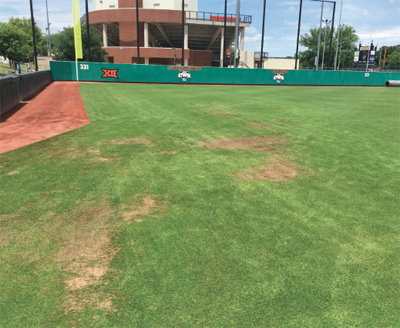
Brown ring patch caused by Waitea circinata was found on three perennial ryegrass cultivars that had been overseeded on a bermudagrass stand at a baseball field in Stillwater, Okla.
Photos by Todd Tribble
Read this story in GCM's digital edition »
First report of brown ring patch caused by Waitea circinata on perennial ryegrass in Oklahoma
Nathalia Graf Grachet, M.S., and Nathan Walker, Ph.D.
Brown ring patch of cool-season turfgrass, caused by Waitea circinata, was first reported in Japan on creeping bentgrass (Agrostis palustris Huds.) in 2005, and in the United States on annual bluegrass (Poa annua L.) in 2007. In April 2015, a rapid decline was observed on a stand of perennial ryegrass (Lolium perenne cultivars Soprano, 1G2, and APR2116) that had been overseeded on a bermudagrass stand at a baseball field in Stillwater, Okla.
Symptomatic leaf tissue was surface-sterilized and plated onto potato dextrose agar (PDA). A Rhizoctonia-like fungus was consistently isolated and suspected to be the causal pathogen. After three days at 77 F (25 C), white, cottony growth formed in the culture, which turned orange to brown as the culture aged. Spherical sclerotia of irregular diameters were present in the 7-day-old culture that followed the same color development as mycelia. Colony and sclerotia morphology were consistent with previous descriptions of W. circinata.
DNA products were sequenced and showed 100% similarity to published ITS sequences (GenBank Accession Nos. HM807352, HQ166071, FJ55889). A pathogenicity test was conducted on 3-week-old perennial ryegrass seedlings of the same cultivar blend on which the disease was initially observed. This blend was grown in 4-inch-diameter (10-cm) pots containing commercial planting mix. One 0.16-inch-diameter (4-mm) plug was removed from the margin of a 4-day-old colony growing on PDA and placed on wet leaves. Five replicate pots of each inoculated and non-inoculated ryegrass seedlings were kept in a moist chamber at 72 F (22 C). Within four to five days, inoculated leaves exhibited slight chlorosis, and water-soaked lesions with white aerial mycelium were present. Koch’s postulates were fulfilled as mycelia were recovered from diseased lesions, and were confirmed through amplification and sequencing of the same ITS region.
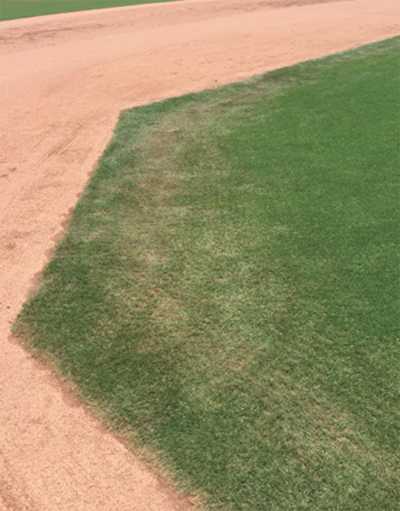
This demonstrates that W. circinata is present in Oklahoma and in the southern Midwest. To our knowledge, this is the first report of W. circinata infecting perennial ryegrass in this region. Given that it has not been previously reported in this region, turfgrass managers may not be correctly identifying this disease.
Source: Accepted for publication in Plant Disease
http://dx.doi.org/10.1094/PDIS-08-15-0906-PDN
Nathalia Graf Grachet is a graduate student and Nathan Walker is a professor in the Department of Entomology and Plant Pathology, Oklahoma State University, Stillwater.
First report of Xanthomonas translucens causing wilt disease on perennial ryegrass in the United States
P.R. Giordano, Ph.D.; Q. Zeng, Ph.D.; N.M. Dykema; A.R. Detweiler; and J.M. Vargas Jr., Ph.D.
Bacterial diseases of turfgrass are rare, but can be devastating because of their prolific nature and the lack of labeled efficacious pesticides. Bacterial wilt of perennial ryegrass (Lolium perenne) was first observed on a golf course fairway in Baltimore, Md., during hot (30 C to 33 C), humid weather in May 2013. Symptoms of general wilt, etiolation, chlorosis and decline were observed on individual plants in irregular areas of the turf stand. Bacterial streaming was present when cut ends of symptomatic plants were observed microscopically at 100×.
The suspected causal agent was isolated by cutting leaf tissue into 1-mm to 3-mm segments, which were macerated with a sterile scalpel. Tenfold serial dilutions up to 1 × 10−4 were performed in sterile saline solution; 10 µl of each suspension was plated onto nutrient agar and incubated at room temperature (21 C) for seven to 10 days.
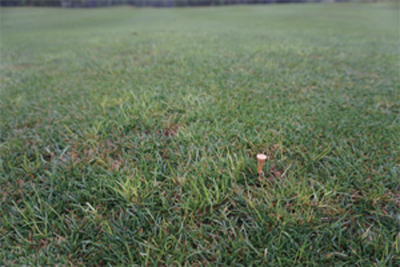
Perennial ryegrass afflicted with wilt disease caused by Xanthomonas translucens was found in Baltimore.
Photo by Eric David
The most frequently observed colonies were mucoid, convex and yellow-pigmented. Pure cultures of the putative pathogen were obtained by selecting single-bacterial colonies to grow in trypticase soy broth medium for 10 days. These were used to inoculate four replicates of Lolium perenne cultivar CSI plants grown in Suremix perlite in 24-ounce (709-ml) foam cups. Healthy perennial ryegrass plants were inoculated with 5 ml of a suspension by adding drops of the suspension to blades of sterile scissors that were then used to cut the healthy plants.
Inoculations with the predominant bacterium obtained from original samples resulted in symptoms of chlorosis and leaf tip dieback after four days, and severe necrosis after seven days. When symptomatic leaves of the inoculated plants were cut, heavy bacterial streaming was observed microscopically. Isolation of the bacterium from inoculated perennial ryegrass plants was performed to fulfill Koch’s postulates. Once isolated, a single bacterial colony was identified via DNA testing, which indicated the causal agent was a member of the Xanthomonas genus, with 100% sequence similarity to X. translucens pv. Graminis (GenBank Accession AY855873.1). The same aerobic, gram-negative bacterium has been consistently isolated from inoculated, symptomatic perennial ryegrass plants thus far. Xanthomonas translucens is a known pathogen on other turfgrass species.
Multiple fungicide applications are typically made in an effort to control this formerly unidentified disease, often misdiagnosed as Leptosphaerulina leaf blight. Understanding this as a bacterial and not a fungal disease should result in a considerable cost savings from ineffective fungicide applications as well as a reduction of their environmental impact. To our knowledge, this is the first report of a bacterial disease affecting a turf-type perennial ryegrass species in the United States.
Source: Plant Disease, September 2015, 99(9):1270
http://dx.doi.org/10.1094/PDIS-01-15-0127-PDN
P.R. Giordano is a turfgrass specialist for Bayer CropScience, Guelph, Ontario; Q. Zeng is an assistant agricultural scientist II in the Department of Plant Pathology and Ecology, Connecticut Agricultural Experiment Station, New Haven, Conn.; N.M. Dykema is a research assistant III/S, A.R. Detweiler is a retired research assistant III, and J.M. Vargas Jr. is a professor in the Department of Plant, Soil, and Microbial Sciences, Michigan State University, East Lansing.
Ergot in perennial ryegrass seed fields in eastern Oregon
Jeremiah K. S. Dung, Ph.D.; Stephen Alderman, Ph.D.; Darrin L. Walenta, M.S.; and Philip B. Hamm, Ph.D.
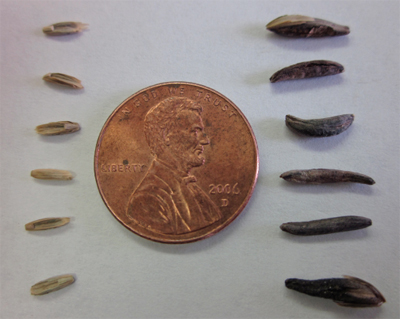
Healthy perennial ryegrass seeds are pictured to the left
of the penny, and ergot sclerotia are on the right.
Photo by Jeremiah Dung
Ergot, caused by Claviceps purpurea, is a major disease of perennial ryegrass grass grown for seed in eastern Oregon. The objective of this research was to quantify and describe the spatial patterns of ergot severity in each of three 123.5-acre (50-hectare) commercial fields of perennial ryegrass grown for seed in 2012 and 2013. A total of 1,433 and 1,405 quadrats were sampled among the three fields in 2012 and 2013, respectively, and the percentage of quadrats with ergot ranged from 59% to 90%. The mean incidence of infected seed heads in each quadrat ranged between 13% and 29%, while mean severity in each quadrat ranged from 0.2 to 0.5 sclerotia per seed head. Significant autocorrelation and clustering were observed in all three fields in both years. The mean number of ergot sclerotia collected from each field after harvest ranged from 4 to 15 sclerotia per 10.7 square feet (1 square meter) in 2012 and from 18 to 119 sclerotia per 10.7 square feet in 2013. Sclerotia left in perennial fields after harvest are a significant source of inoculum that should be targeted for control. This is the first study to quantify spatial patterns of ergot in perennial ryegrass, and it provides insight into possible mechanisms that contribute to ergot etiology and epidemiology.
Accepted for publication in Plant Disease
http://dx.doi.org/10.1094/PDIS-08-14-0787-RE
Jeremiah K. S. Dung is an assistant professor based at Oregon State University’s Central Oregon Agricultural Research Center in Madras, Ore.; Stephen Alderman is a research plant pathologist at the USDA-ARS National Forage Seed Production Research Center, Corvallis, Ore.; Darrin L. Walenta is an assistant professor at Oregon State University in LaGrande, Ore., and an Extension agronomist for three counties in the state; Philip B. Hamm is professor emeritus, plant pathologist and station director at Oregon State University’s Hermiston Agricultural Research & Extension Center in Hermiston, Ore.
First report of Hemicycliophora wyei on bentgrass in Texas
X. Ma and P. Agudelo, Ph.D.
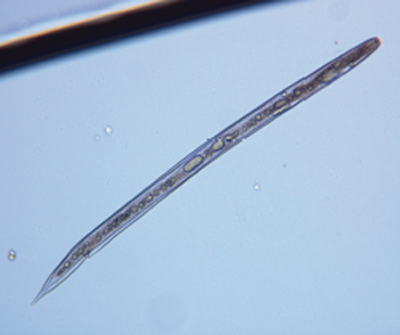
The sheath nematode species found in a creeping bentgrass putting green in Dallas was identified as Hemicycliophora wyei.
Photos by Xinyuan Ma
Creeping bentgrass (Agrostis stolonifera L.) is an important component of putting greens in the southern United States. In 2012 and 2013, soil samples from a private golf club in Dallas were received at the Clemson University Nematology Assay Laboratory. Nematodes were extracted from the soil by sugar centrifugal flotation and observed under the stereoscope. Sheath nematodes were found at an average density of 258 (140 to 400) individuals per 6 cubic inches (100 cubic cm) of soil in 14 of 14 samples processed from symptomatic turf. No sheath nematodes were found in six samples from healthy turf. Reported symptoms in the turf included general decline and poor stand quality.
Identification of the sheath nematode species was done by morphological examination of 10 females. Characteristics determining the specimens as Hemicycliophora wyei include: cuticular sheath loosely fitting the body; lateral lines with breaks and anastomoses; labial disc elevated with two lip annuli; vulva with modified lips and vulval sleeve long; tail uniformly tapering with a conical post-vulval region; body length = 1,001 µm (945 to 1,153 µm); and tail length = 107.7 µm (100 to 112 µm). No males were observed. This species was recently described from specimens associated with turfgrass in North Carolina, but no pathogenicity studies are available. Molecular diagnosis was confirmed using sequences from two ribosomal DNA markers from five individuals. The sequences obtained from amplification were submitted to the GenBank database and assigned accession number KC329574 for D2-D3 of the 28S gene, and KC329575 for the ITS1-5.8S-ITS2 region. These sequences were the first submitted for this species. At the time of submission, the closest match was H. lutosa (93% identity). Additional sequences for H. wyei were later submitted by other scientists, and these sequences were 99% identical to ours.
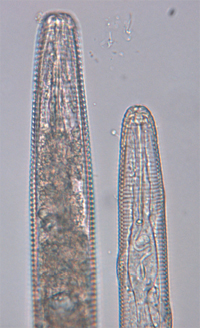
Host suitability was tested in the greenhouse by growing the same varieties of bentgrass (blend of 70% Tyee and 30% 007) in 6-inch-diameter (15-cm) plastic pots filled with sandy soil that meets USGA recommendations for greens. The soil was inoculated with 250 sheath individuals per 6 cubic inches (100 cubic cm) of soil. Six months after inoculation, final populations were 950 (430 to 1,640) individuals per 6 cubic inches of soil, confirming bentgrass is a suitable host for H. wyei. To date, this nematode has been reported only in North Carolina on an unspecified turfgrass species, and in Florida on Andropogon virginicus (broomsedge bluestem). Awareness of the host status of this newly described species, which is potentially harmful to bentgrass, is relevant to the maintenance of golf course turf. To our knowledge, this is the first report of H. wyei in Texas, and the first report of this species on bentgrass.
Source: Plant Disease, May 2015, 99(5):732
http://dx.doi.org/10.1094/PDIS-09-14-0972-PDN
Xinyuan Ma is a graduate research assistant and Paula Agudelo is an associate professor in the Department of Agricultural and Environmental Sciences at Clemson University, Clemson, S.C.